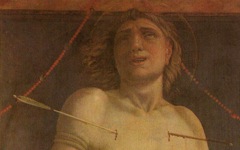Mantegna’s Adoration of the Shepherds (c.1450-51)
Joseph, worth only a cameo appearance in the Bible, is a major star in visual art. Cast as a narcoleptic, he falls asleep in one image after another without any art historian, to my knowledge, pausing to ask: Why does he sleep so much? The answer for artists is that Joseph represents the dreaming painter whose imagination brings forth the "divine painting" behind him, in this case "Mantegna's Virgin and Child". Joseph, after all, was a craftsman like the artists themselves. Joseph's "painting", the Virgin and Child, are in a different reality to himself and the shepherds. However, even Mary and her child, the two figures in the "imagined" painting, are in their own turn visual metaphors for the artist and his painting. Here's how. The Italian word for conception in art also meant idea, as it does in English too. Thus the Virgin as the artist's alter ego has an Immaculate Conception, the "Christ Child", art's iconic subject and the symbol of a purified soul.

Mantegna, Adoration of the Shepherds (c.1450-51) Tempera on canvas. The Metropolitan Museum of Art, New York.
Click image to enlarge.
The visual proof that Mantegna identified with the Virgin and her Immaculate Conception is that the shepherds bow not to Christ, as spectators and art scholars naturally imagine, but to Joseph, the dreaming artist. Look carefully because your initial assumption probably misled your sight. You thought they faced Christ and could not see that they actually face Joseph instead1. The shepherds, as substitutes for the artist’s audience, come to adore the dreaming artist and his Immaculate Conception.
More Works by Mantegna
See how Mantegna like many other masters uses the Execution of St Sebastian to convey the idea that 'every painter paints himself.'

Mantegna’s Saint Sebastian (1480)
Notes:
First published here 19th April 2010. Re-issued 1st July 2012.
1. I am indebted to Francesca Del Rio for this insight.
Original Publication Date on EPPH: 01 Jul 2012. | Updated: 0. © Simon Abrahams. Articles on this site are the copyright of Simon Abrahams. To use copyrighted material in print or other media for purposes beyond 'fair use', you must obtain permission from the copyright owner. Websites may link to this page without permission (please do) but may not reproduce the material on their own site without crediting Simon Abrahams and EPPH.


